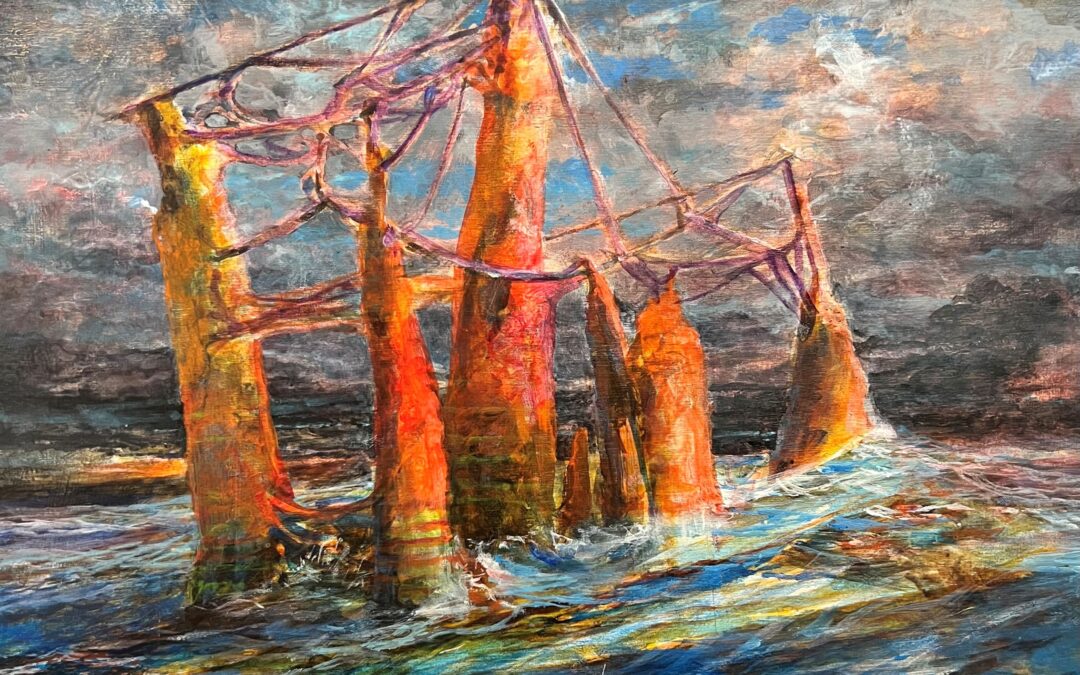By Betsy DiJulio
A quick look at the paintings and drawings of Solomon Enos would leave one with the impression that his work gives form to a dystopian, post-apocalyptic future. But that’s why a quick look at art is rarely adequate.
While the work leans heavily into sci-fi and fantasy—with echoes of surrealist Salvidor Dali’s looming anthropomorphic objects in barren landscapes—this self-described “radical optimist” depicts a landscape that appears “radically” different than our current world. But in this world, people have joined forces to “dream new dreams,” bringing the best of who we are to bear on the recalcitrant dilemma of climate change. And as Enos has asserted in a parallel discussion about other ravages and ramifications wrought by humans, “…if we can harness great power to facilitate destruction, we too can move in the polar opposite direction and turn our hands, minds and hearts to profound systems of peace.”
Born and raised in Makaha Valley (O‘ahu, Hawai‘i), the artist hails from the well-known Enos ‘ohana. Viewing Hawaii as a microcosm of the larger world, he states, “We have the capacity to bring new perspectives and ideas to seemingly intractable conflicts.” Twenty or so years ago, when the Pacific’s “slow ascent” came to be more widely acknowledged, some of the most innovative thinkers of Oceana in the South Pacific Ocean pooled their political and scientific knowledge, attitudes, experiences, and resources to spearhead a broad effort to quite literally “stem the tide.” It is as part of those continuing efforts that Enos takes his place.
In his role as an art activist, the self-taught Enos believes he has “the opportunity to test out concepts on paper with the hope that something useful can emerge…” Put simply, says Cullen Strawn, PhD, ODU’s Executive Director for the Arts, Enos believes that if he can imagine it, someone can make it possible. And exactly what is “it”? Enos’s fertile imagination has conceived of a not-too-distant future in which solar power, bots, extruded plastics, 3-D printed bridges, hanging gardens, floating promenades, and forested facades are synthesized into built environments that coexist with natural forces and rhythms.
“Papahanaumoku,” the title of the show at the Baron and Ellin Gordon Art Galleries, references one of the foundational mo‘olelo or stories, telling of the mother, Papa, who birthed the islands, from Hawai‘i island to Kaua‘i and beyond. Works created for this exhibition—some of them on site using the wall as a palette–offer what the gallery staff writes is “a conceptual continuation of the peopling of islands, as the effects of climate change reshape our planet’s land masses, ecologies, and societies.”
Threading through Enos’s overall body of work are ideas about identity, ancestry, ecology, and the collective-consciousness. Numerous community mural projects, commissions for hotels, corporate offices, public buildings, and schools, murals, book illustration, and game design—including for blue chip clients like Disney and Google—are all part of one creative flow: Enos’s passion and deep-rooted connection to the land and surrounding waters his wellspring.
Engaging with local issues that resonate nationally—including in Coastal Virginia—and internationally, Enos is a firm believer in first-hand engagement with the effects of our changing climate such as he experienced in the Marshall Islands. “The influence that travel can bring, especially with immersive opportunities to work in community through the arts condenses a wealth of information and ideas into a seed from which whole forests can flourish. The work there is to do to heal, protect, and empower our native lands and her peoples must be done in concert with movements around the world.”
And Enos aims to help nurture that seed by using “new tools to replace old weapons.” Toward that end, he wields his brush and pencil, while also contributing to the cause his indomitable effervescence as a generous, curious, knowledgeable, and loquacious “possibilist.”
WANT TO SEE?
Papahanaumoku: A Panoply of New Island Cultures
Works by Solomon Robert Nui Enos
Through December 16
Baron and Ellin Gordon Art Galleries, Old Dominion University
www.odu.edu/life/culture/arts/galleries




